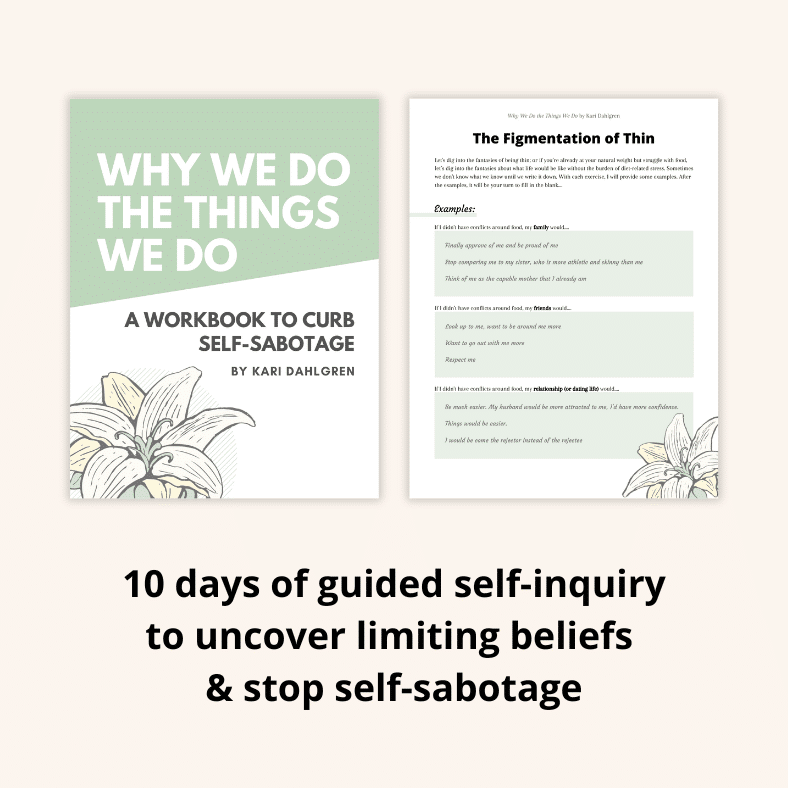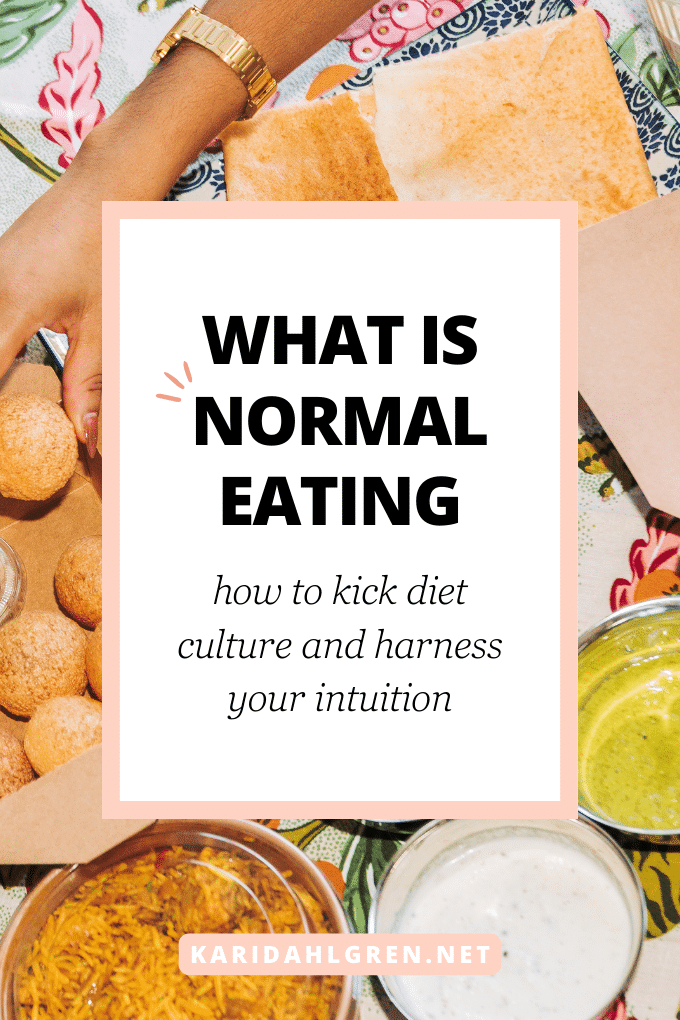
Chances are, when you were three years old, you weren’t asking your parents, “What is normal eating?” Chances are, you ate when you were hungry and stopped when you were full. It was so natural that you barely had to think about it; and once you ate, you completely stopped thinking about it and moved on.
Dieting often strips away this freedom. It sows seeds of doubt in our food choices and can escalate into an unhealthy preoccupation or obsession with food. Excessive or long-term dieting not only disrupts our natural intuition but also jeopardizes our mental well-being. It’s not uncommon for chronic dieters to find themselves consumed by thoughts of food all day, every day.
Normal eating is intuitive, natural behavior. It’s the way you ate when you were a small child. On the other hand, dieting is learned behavior. When over-practiced or excessively employed, dieting can override our intuition. Given that our culture is fixated on dieting and body image, it’s arguably more common to feel estranged from normal eating than to feel familiar with it.
Diet culture is rampant, but it can be unlearned with time and practice. You can find your way back to ‘eating like a normal person’ again — or as I like to say, feeling normal around food. This article is a deep dive into the essence of normal eating for those who crave liberation from yo-yo dieting.
What Is Normal Eating?
Normal eating is the practice of following your intuition to inform what and when to eat. It means eating what appeals to you when you're hungry and stopping when you're full. Homeostasis — the body's self-regulating way of maintaining balance — comes naturally with normal eating. This means your weight, which is often of great concern for dieters, will regulate itself.
Homeostasis is involved in every organ system in the body.[1] The body naturally knows how to maintain balance, including what kinds of foods it needs and how much food it needs to maintain a healthy weight. When we follow our intuition and eat normally, homeostasis is inevitable. When we deviate from our intuition and begin to follow an external set of rules, like a diet, we run into trouble.
Think about it: infants cry when hungry and stop eating once they’re full, drawing solely from their inherent instincts. This intrinsic sense continues into adulthood, but often, societal pressures and a barrage of dietary advice overshadow it.
One of the most marvelous aspects of our physiology is that constant striving for balance or homeostasis. When our energy reserves dip, our stomach signals hunger via the ‘hunger hormone’ ghrelin guiding us to eat.[2] Conversely, when we’ve had enough, we experience satiety via the ‘fullness hormone’ leptin signaling it’s time to stop.[3]
But it’s not just about the mechanics of hunger and satiety. Our body’s intuition envelops a holistic view of our health. This wisdom understands the complex interplay between our physical health, emotional well-being, and environmental factors. For instance, after a particularly strenuous day or during moments of emotional stress, our body might naturally crave foods rich in energy and comfort.
Intuitively, we just know this, and clinical studies can back it up. In one study, stress was found to promote “the wanting and seeking of hyperpalatable foods [those high in fat, carbs, sugar, and/or salt], as well as induce metabolic changes that promote weight and body fat mass.”[4]
In other words, it intuitively makes sense that we crave comfort foods during times of stress and that stress makes weight gain more likely. Clinical evidence supports this.
When we strip away the influence of diet culture, one might intuitively know that restricting the foods they like during times of stress would only increase their stress even more. In embracing normal eating, we’re not just opting for a dietary choice. We’re choosing to trust our body’s profound intelligence, to believe that it knows how to maintain its health and balance.
Over time, as we consistently heed these internal signals, we can rekindle a harmonious relationship with food, one where meals become moments of nourishment, joy, and trust in our body’s intuitive wisdom.
Deciphering ‘Normal Eating’ in a Diet-Driven Culture
Dieting is rampant in our society — almost to the point where you’re weird if you aren’t dieting — and this has led us away from normal eating. We find ourselves caught in this tumultuous dance of weight fluctuations, where every step we take seems choreographed by external pressures. When the scale goes up, we pull out the food rules. When the scale goes down, we’re ‘allowed’ to celebrate and actually feel good.
Although many of us know what good food and exercise entails, why do we end up eating in secret while standing in front of the fridge at midnight after a week of ‘eating well’? It isn’t a lack of will or discipline; it’s deeply connected to how our bodies naturally respond.
Our bodies are designed and wired for survival. When you place yourself on a strict calorie-deficit diet, the body reacts defensively. You’re not just battling hunger but evolutionary hardwiring. The hunger hormone ghrelin starts ringing more often. In contrast, the body’s mechanisms to feel full weaken.[5] Add to this the fact that the body slows its calorie-burning rate to conserve energy, and you’re faced with a dilemma diametrically opposed to your weight-loss goals.[6]
Yet, it’s not just about physiological signals. There’s a deeper emotional undercurrent at play. Think about it: how many times have you felt guilty after ‘giving in’ to a craving? This restrictive mindset often distorts our emotional state around food. Instead of a source of nourishment and pleasure, it becomes an arena of self-judgment.
But here’s where we pivot and reimagine what ‘normal eating’ means.
While dieting revolves around stringent rules, 'normal eating' champions listening to your body's natural cues. It's about recognizing and honoring what your body truly needs, without the specter of guilt looming overhead.
In the contemporary hustle, where diets are often presented as the ‘silver bullet’ to health and happiness, ‘normal eating’ is about stepping back, reevaluating, and realigning. It’s about achieving a harmony between physiological needs and emotional well-being. Ultimately, the goal isn’t just about weight or appearance, but fostering a genuine, guilt-free relationship with food.
Steps to Start Eating Normally
Embarking on a journey to eat normally involves far more than just food; it encompasses a holistic approach to reconnecting with our bodies, understanding our emotions, and letting go of deep-seated diet mentalities.
That’s my goal here with Psycho-Spiritual Wellness, my approach to stopping compulsive eating rooted purely in psychological and spiritual practices, not dieting. The ultimate goal is to feel normal around food.
Here are some steps to guide you on this transformative path:
- Tune into Hunger and Satiety Signals: Our bodies are equipped with natural cues to indicate hunger and fullness. Rediscover and trust these signals; they guide us in understanding when to eat and when we’re satisfied. If you’ve been entangled in diet culture, these cues may seem faint, but with patience, they’ll become more apparent.
- Differentiate Physical from Emotional Hunger: It’s essential to discern between eating because your body needs nourishment and eating to soothe emotions. Emotional eating often stems from a desire to cope with stress, sadness, or other emotions, while physical hunger is the body’s way of signaling a need for fuel. My Stop, Drop, & Feel method can help with this.
- Ditch the Diet Mentality: Dieting often promotes a restrict-binge cycle and tags certain foods as “off-limits,” leading to unhealthy relationships with those foods. Embrace an approach that allows you to enjoy all foods in moderation, paying heed to your body’s desires.
- Listen to Your Body: Your body is wise. It knows what it needs and communicates that through various signals. By paying attention and learning its unique language, you’ll cultivate a more intuitive eating style.
- Cultivate a Healthy Relationship with All Foods: What we resist, persists. By granting yourself the freedom to enjoy all foods without guilt, they lose their overwhelming allure.
- Prioritize Satisfaction in Eating: Eating should be a pleasurable experience. When we choose foods that genuinely satisfy us, we’re more likely to feel content and less inclined to overeat. For example, when you feel full but not satisfied after eating, it’s likely because you were following food rules instead of your intuition.
- Recognize and Address Emotional Eating: Tackling the root causes of emotional eating is pivotal. Tools like the Stop, Drop, & Feel method can help you confront and process emotions instead of masking them with food. It helps you develop awareness and tolerance for the uncomfortable emotions that drive compulsive eating.
- Practice gentle nutrition. At its core, gentle nutrition means making food choices based on what feels good and nourishing for your body without adhering to rigid dietary rules. It emphasizes holistic well-being, acknowledging that health isn’t solely dictated by nutrient intake but also by emotional and mental well-being.
I mentioned my Stop, Drop, & Feel method twice in the list above, which illustrates how relevant it is for relearning ‘how to eat like a normal person.’ (I put this in quotes because, although it’s a goal that most of us can relate to, ‘normal’ looks different for everyone.)
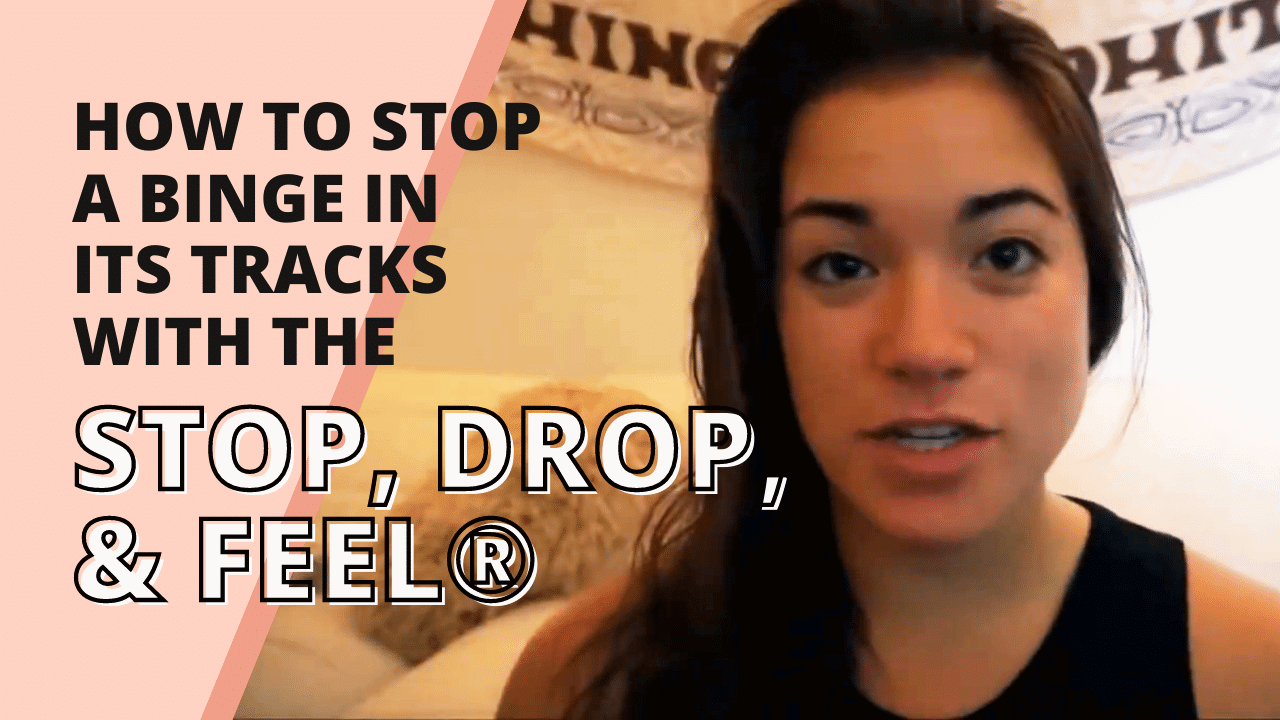
In my personal experience and years coaching others, whenever there’s a desire to eat without hunger, there is an uncomfortable emotion floating around that needs your attention. The Stop, Drop, & Feel helps you develop awareness and tolerance for the uncomfortable emotions that drive compulsive eating by asking you to drop into your feelings at the precise moment when you want to eat without hunger.
Check out the video above to learn more, or head over to my blog post on the Stop, Drop, & Feel for specifics on how to use this tool to stop emotional eating. Also, if you’re keen to delve deeper into the nuances of eating normally, check out my detailed article on How to Stop Dieting and Eat Normally for a comprehensive guide.
The Role of Mindfulness in Eating
Were you surprised that mindful eating wasn’t on the list above? Mindfulness in eating is heralded by many as the golden key to discovering the true nature of our relationship with food. It encourages us to be present during meals and slow down to relish each bite.
Studies have even shown that paying attention to the food you eat results in eating less than mindless eating (i.e. eating while staring at a television).[7] In this light, mindful eating out to be a critical part of the agenda for those looking to ‘eat normally,’ right? Not in my personal opinion!
The goal of normal eating isn’t to trick yourself into eating less. It’s to create a healthy rhythm between you and food; a rhythm where you’re satisfied and content with the food you eat. If you have a long, hard day and all you want is a bowl of pasta in front of the television, who is to say that’s ‘bad’? Labeling it as such defeats the purpose of stepping away from dieting towards normal eating.
In my previous reflections on mindful eating, I illustrated why I don’t agree with mindful eating specifically for compulsive eaters. While there is no doubt a benefit to it (and if you have the patience for it, please have at it!) most compulsive eaters can’t simply “decide” to be present at every meal.
Compulsion is compulsive for a reason. When we tell ourselves that we will eat every meal without distraction and end up ‘falling off the wagon,’ we berate ourselves with self-criticism just like we do when we ‘fail’ at dieting!
I would much rather you pour your energy into the Stop, Drop, & Feel before focusing on mindful eating. While mindful eating is undoubtedly helpful, the Stop, Drop, & Feel is more effective for stopping compulsive eating, which is better for facilitating a normal relationship with food.
The Stop, Drop, & Feel helps you develop the evergreen skill of emotional tolerance. When you build your emotional tolerance over time, compulsive eating reduces over time. Conversely, practicing mindful eating doesn’t always result in getting better at mindful eating if the emotions that drive compulsive eating remain unresolved.
it’s kind of like rebuilding a car where mindful eating is like upgrading your engine and the Stop, Drop, & Feel is the keys to that engine. An upgraded engine is undoubtedly beneficial for the performance of the car but not necessary for getting going. But the keys to the engine? You can’t get anywhere without it.
What You Have to Look Forward To: The Benefits of ‘Normal Eating’
Relearning how to eat normally and what it means for you to ‘eat like a normal person’ again (as it’s unique to everyone) is a process. It personally took me years to get there, and I hope the advice here helps you get there faster than me. One thing that might help is to set your eyes on the wonderful benefits waiting for you on the other side of diet culture.
Here are some benefits that you can look forward to as you heal your relationship with food and slowly find your own answers to the question, What is normal eating?
1. Improved Mental Well-Being
Improved mental health is one of the most significant byproducts of relearning ‘how to eat like a normal person.’ Studies have found that intuitive eaters tend to have “lower odds of high depressive symptoms, low self-esteem, high body dissatisfaction, unhealthy weight control behaviors (e.g., fasting, skipping meals), extreme weight control behaviors (e.g., taking diet pills, vomiting), and binge eating at eight-year follow-up.”[8]
In other words, you’ll feel better and be less likely to remain stuck in the restrict-binge cycle when you ditch dieting and adopt an intuitive, normal style of eating. And an 8 year follow-up is a big deal!
2. A More Stable Weight
Another research study illustrated the importance of embracing health at every size and intuitive eating, especially in contrast to restrictive dieting. The study found that participants who adopted the health at every size approach were not only more likely to stick with the program but also maintained their weight over two years.[9]
Conversely, while those in the diet group lost weight initially and had some early health benefits, they regained the weight within two years and saw a decline in health improvements over time. This suggests that the holistic approach of size acceptance, reduction in dieting behaviors, and being attuned to body signals is more sustainable and beneficial than transient weight loss from dieting.
3. Naturally Eating More Fruits and Veggies
A study published in the Journal of Nutrition Education and Behavior discovered a fascinating link between intuitive eating and increased fruit and vegetable intake. They found that adults, both men and women, in the highest quartile of intuitive eating (those considered the ‘most’ intuitive eaters) consumed more daily servings of fruits and vegetables compared to those in the lowest quartile (those considered the least intuitive).[10]
This study illustrates that intuitive eating may guide you naturally toward healthier dietary patterns in the long-run. Try not to let this undermine your efforts as you don’t want to “aim” for eating more fruits and vegetables, as that may feel restrictive. Instead, simply look forward to the evidence-based phenomenon that you’ll naturally end up eating more fruits and veggies the more intuitive your relationship with food becomes!
4. Eliminating the Stress and Guilt Associated with Food
Research published in Eating Behaviors explored the detrimental effects of weight-related shame and guilt, especially in relation to binge eating. It revealed that such negative emotions were linked to increased binge eating behaviors. Yet, importantly, intuitive eating played a crucial role in mediating this relationship.[11]
Specifically, intuitive eating diminished the correlation between weight-related shame and binge eating. This suggests that by embracing an intuitive, normal style of eating, you can alleviate the burdens of food-related guilt and shame that many people grapple with. For countless people, myself included, this represents a liberating step towards food freedom and self-acceptance.
How to Eat Like a Normal Person Again
By now I hope that I’ve convinced you that adopting a more relaxed, intuitive style of eating can help you improve your mental and physical health while relearning ‘how to eat like a normal person’ again. Dieting is learned behavior that often disconnects us from our body’s signals, whereas normal eating means listening to those internal cues of hunger and fullness again. It allows you to shake free of guilt and anxiety and get back to feeling normal around food.
Relearning what normal eating looks like for you, personally, involves differentiating between physical and emotional hunger, and prioritizing satisfaction in eating, and listening to your body instead of external food rules, among many other steps. (Don’t forget to see my robust article on how to stop dieting and eat normally for more detail.)
Where are you on the journey back to normal eating? How are you slowly untangling the food rules and deprogramming diet culture? Leave me a comment below!
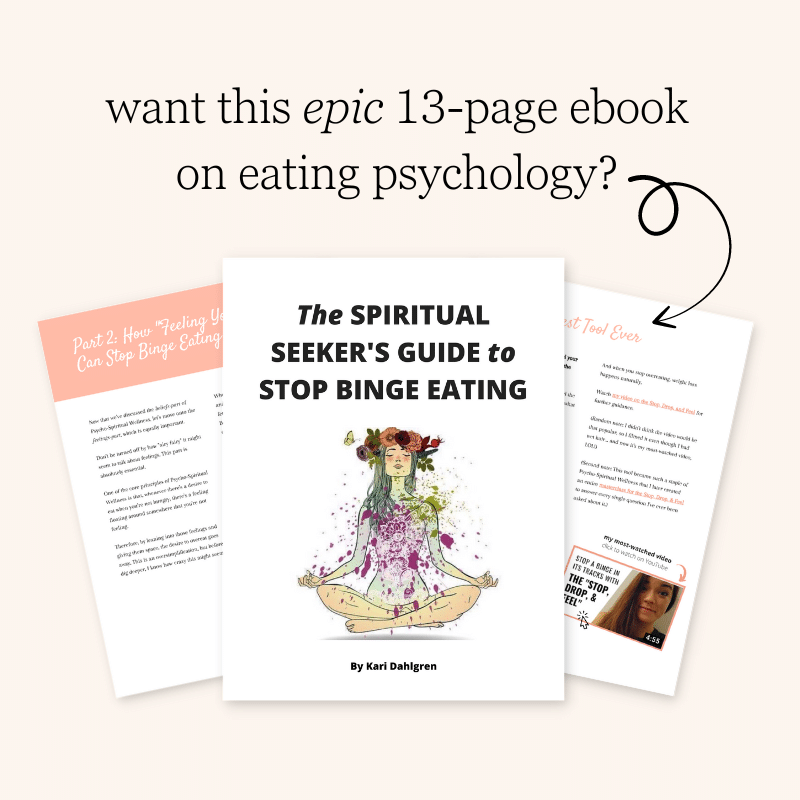
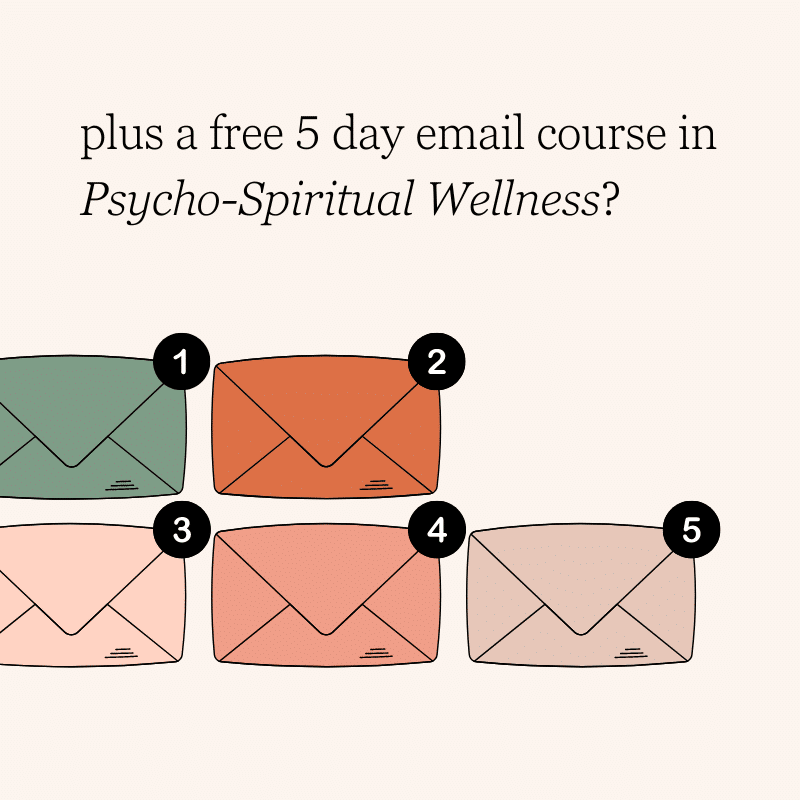
![best seller [cover of Why We Do the Things We Do]](https://karidahlgren-net.b-cdn.net/wp-content/uploads/2023/09/why-we-do-the-things-we-do-1.png)
